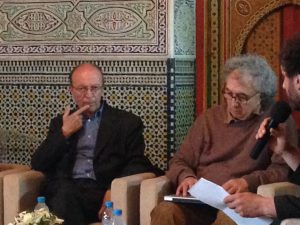The philosopher and former head of the CCM (Centre du Cinéma Marocain) was in his native city to attend the 20th edition of the Salon International de Tanger des Livres et des Arts, organized by the French Institute. The theme this year was “Tangiers as a Symbolic City: from Fantasy to Reality”. Asked to address cinema in Tangiers, Saïl took a detour via the cinema houses of his childhood and teenage years. He developed a Tangerine topography of picture-houses along the two axes of space and time: the medina corresponded to early childhood; the larger city of Tangiers to teen-age years. He first evoked two old movie theaters that are now reduced to spectral architectural presences in the city: The Capitol and the Alcazar.

The Capitol specialized in westerns, and introduced the six or seven year old to John Ford and his narrative strategies, and all sorts of other American films. The films were dubbed in Spanish (the city still had its international status at the time) – so much so that Saïl would be shocked to discover, at age thirteen, that Cary Grant actually spoke English! The second theater, L’Alcazar, specialized in Spanish and Mexican romance and comedy. It was the theater where Joselito was the singing star of El Pequeño Rosiñol. The children had no clue Franquist Spain was busy spreading its messages through the charming little boy. They sang with him…
As the Tangerine children grew to reach the ripe age of ten, the circuit of movie theaters would widen and include Cinéma Vox, “the total capital of Egyptian cinema”. This is where they discovered Anwar Wagdi’s 1949 Egyptian classic Ghazal al Banat / The Flirtation of Girls, finally released in Tangier in 1957. To Saïl, this was “a complete earthquake of the senses, each component of the film having reached its utmost completeness”. The photography, the music, the dance, the range of emotions held the children under an enduring spell.
All these cinemas, Noureddine Saïl added, were part of the medina, i.e. steeped in an idyllic Tangier made of multiple cultures, languages, mores, religions, cuisines, in which people lived in a form of consensual conviviality. Stepping out of the perimeter of these picture houses through the Rue de la Liberté (sic!) meant venturing into a less colorful territory. But only there, at age fourteen, was he given the chance to see Buñuel’s surprising films at the Mauritania. This was a costly endeavor: all films at the Mauritania were twice the price of those at l’Alcazar. So the kids of Tangier would wait for “the film to come down to the Alcazar” for a couple of months, and resume their attendance at the old medina theater where the less intellectual films ended up… At the Mauritania, though, it was clearly the more complex films that attracted the teens.
“Through the Tangier of the time, we developed in a schizoid way (seeing films in all languages, speaking several ourselves) where, elsewhere, people develop in a paranoid way. Cinema was part of that.”
Florence Martin